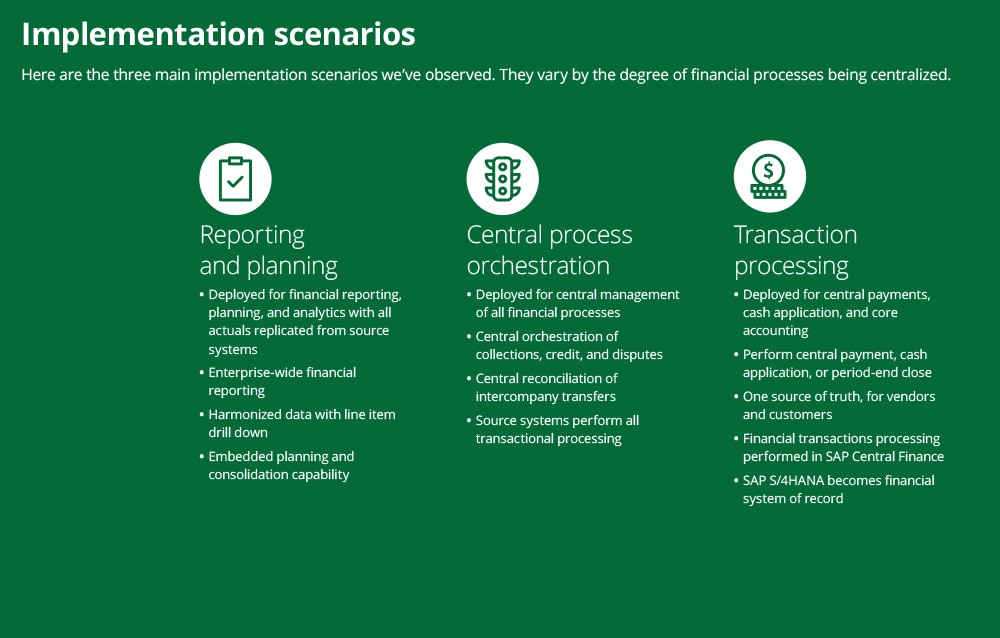The CFO guide to SAP S/4HANA® and Central Finance has been saved

Perspectives
The CFO guide to SAP S/4HANA® and Central Finance
When and how to implement SAP S/4HANA
For many CFOs, deciding when and how to implement SAP S/4HANA could be the most significant technology investment choices of their career. It’s a big deal. SAP HANA® is SAP's brand of in-memory computing, a technology that handles massive data sets without breaking a sweat. SAP® built its latest next-generation intelligent ERP (SAP S/4HANA) around this technology. SAP launched SAP S/4HANA in 2015 and plans to stop supporting older ERP versions on December 31, 2027. SAP reports more than 12,000 customers have committed to SAP S/4HANA.¹
What’s different and better about SAP S/4HANA?
Traditional ERP systems are optimized for transaction processing, with data stored in many different tables. SAP S/4HANA uses its Universal Journal to store all financial transaction details in one table. Availability and access to all that data can happen with near-zero latency. The new system also brings a simplified data model that lets you record once, use many times, and create a single source of truth. So analytics and insights that were historically unfeasible or very time consuming now process quickly.
SAP S/4HANA enables more speed and better insights in almost every area of finance. It’s also a platform for real-time analytics—with no more waiting for separate reporting systems, batch jobs, and long processing times. Yes, it can be expensive, and yes, there may be implementation risks, but defining a digital transformation roadmap upfront, driven by prioritized capabilities that drive value for the business, can help address both cost and risk in a positive way.
Factors to consider
As you weigh the decision of when and how to implement SAP S/4HANA, consider these factors:
- Do you have a reconciliation process that seems to go forever at the end of each month? SAP S/4HANA provides an additional level of detail through its Universal Journal capabilities, allowing complete transparency to a reconciled ledger that enables accounting and corporate shared services to manage an "anytime" close and possibly eradicate the need for a month-end close altogether.
- Can you look at true product costs without the noise of messy intercompany transactions and markups? SAP S/4HANA’s valuation process allows you to "see through" your cost to the underlying components.
- Does your team struggle with time-consuming forecasting that is out of touch with actuals—and which leaves little time for analysis? SAP S/4HANA’s embedded planning offers a unified information model with prebuilt forecasting methods.
- Do you have one source of record to support consolidated, management, and statutory reporting? SAP S/4HANA lets you drill down from your consolidated financial statements to the business transaction.
How to speak SAP

SAP HANA: With traditional systems, data was placed in storage and accessed upon request. That takes time. With SAP HANA, data is stored "in memory" and can be accessed instantaneously.

Universal Journal: Provides the basis of an integrated accounting system where financial accounting and management accounting data are recorded in a single chart of accounts. SAP’s Universal Journal concept facilitates the synchronization of all financial data and stores it in one place, automating reconciliation between financial and management accounting.

SAP Fiori®: Delivers an intuitive, role-based user experience across all lines of business, tasks, and devices. SAP Fiori technology presents financial information that is logical, accessible, and visualized in a manner that supports improved job performance, allowing users to transact and report all from one application, simplifying the user experience.

SAP Central Finance: Also known as CFIN, this part of SAP S/4HANA brings financial transactions from legacy ERPs—SAP or non-SAP systems—into the SAP S/4HANA table with a common data format. Harmonizing the finance data set is often the first step in digital finance transformation journeys.
Are you ready for this?
Will every company using SAP today step up to SAP S/4HANA? Probably not every company, but this is a watershed moment for SAP customers. Among organizations sticking with SAP, four factors seem to be shaping their decisions:
- The first factor is a competitive risk. Companies already moving to SAP S/4HANA will get the benefits sooner, and those benefits can be substantial. There also are risks in waiting, as SAP will end support of legacy versions at the end of 2027.
- A second factor is the degree of growth and business complexity you foresee. If your future includes acquisitions, divestitures, and evolving business models, SAP S/4HANA can help make life easier.
- A third factor is the quality of your current SAP installation and other enterprise systems. Companies that have their SAP house in order and their systems fully integrated may not feel immediate pressure to get on board the SAP S/4HANA train.
- A fourth factor is data quality. Many companies are still struggling to get their data acts together. For those with multiple instances of SAP or other ERP systems, SAP S/4HANA is an opportunity to pull the entire enterprise into financial alignment around a tested set of simplified processes.

SAP S/4HANA deployment options
SAPinsider says that a little more than half of SAP customers planning SAP S/4HANA investments are opting for either new implementation or system conversion.2
Those choosing a new implementation typically want to eliminate custom programs, shed ineffective practices, and drive more standardization around best practices. Organizations that implemented SAP when they had simpler business models, different competitors, and a less demanding customer base find this approach allows for remodeling to support productivity and growth. It also lets them start afresh and keep their ERP clean.
Those choosing system conversion usually want to preserve some of their custom environments and have business models that have not evolved. They see this as a lower-cost path, one that could require less change management. This approach is often used by companies that completed SAP implementation within the last five to seven years. These companies don’t need to transform, but they want to take advantage of the SAP S/4HANA digital platform.
For many SAP customers, a new implementation or system conversion can be combined with a third implementation option: leveraging SAP Central Finance.
SAP Central Finance allows companies to deploy a single instance of SAP S/4HANA Finance and then integrate some or all their financial and operational processes back through that instance. A company’s current SAP or non-SAP financial systems don’t need to be converted and can remain in their existing environments.
SAP Central Finance
Deloitte has more than 110 SAP S/4HANA implementations currently underway, with a significant portion of clients leveraging Central Finance as a low-risk, high-value path forward. With more than 30,000 hours of co-innovation partnering with SAP on SAP S/4HANA, here’s what we know from our experience:
- Stepping stone. Central Finance is frequently used as a first step—an efficient mechanism for beginning broader ERP deployments. It allows business units to transact in legacy systems uninterrupted during implementation.
- Centralized services. Central Finance enables centralized service delivery models to report, model, and analyze data within a single system and across a common information model, further driving value from the shared service center.
- Data bridge. Central Finance is frequently thought of as the least invasive hub to bring data together in a common information model across multiple ERPs. This gives companies visibility into transaction data that would otherwise be masked in aggregated summary data tables or be in a completely different format altogether.
- Accelerator. Central Finance acts as a hub to accelerate merger integration or separation by allowing companies to continue to transact in legacy systems.

Things you can do now
Final thoughts
Companies committed to SAP will likely find themselves grappling with SAP S/4HANA decisions over the next five years. Making choices earlier—building in time for your teams to influence both the overall vision and the implementation options—should increase the odds of getting things right.
Explore other "Crunch time" reports and case studies
Explore other reports and guides in our Finance in a Digital WorldTM "Crunch time" series, and read case studies about digital transformation in the finance function. Whatever your interest, one thing is clear: From cloud computing and robotics to analytics, cognitive technologies, and blockchain, a new class of digital disruptors is transforming how the work of Finance gets done.

Endnotes
1 SAP press release, October 2019.
2 SAPinsider Benchmark Report, SAP S/4HANA Finance: State of the Market, 2019.

Recommendations
Crunch time 9: Tax in a digital world
Digital tax transformation and the role of finance
Case studies on Finance transformation
Real-world stories for real-world finance issues





